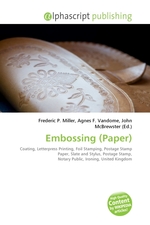Embossing (Paper)
Frederic P. Miller, Agnes F. Vandome, John McBrewster
бумажная книга
Please note that the content of this book primarily consists of articles available from Wikipedia or other free sources online. Embossing is the process of creating a three-dimensional image or design in paper and other materials. Embossing is typically accomplished by applying heat and pressure with male and female dyes, usually made of copper or brass, that fit together and squeeze the fibers of the substrate. The combination of pressure and heat raises the level of the image higher than the substrate, while "ironing" it to make it smooth. In printing this is accomplished on a letterpress. The most common machines are the Kluge Letterpress and the Heidelberg Letterpress. "Debossing" is similar to embossing, but recesses the design rather than raising it. Most types of paper can be embossed, and size is not normally a consideration. Embossing without ink, so that the image is raised but not colored, is called "blind embossing." Embossing used in conjunction with ink, so that the raised area is colored, is called "color register embossing." Embossing used in conjunction with foil stamping is called "combination stamping" or "combo stamping."
Данное издание не является оригинальным. Книга печатается по технологии принт-он-деманд после получения заказа.


